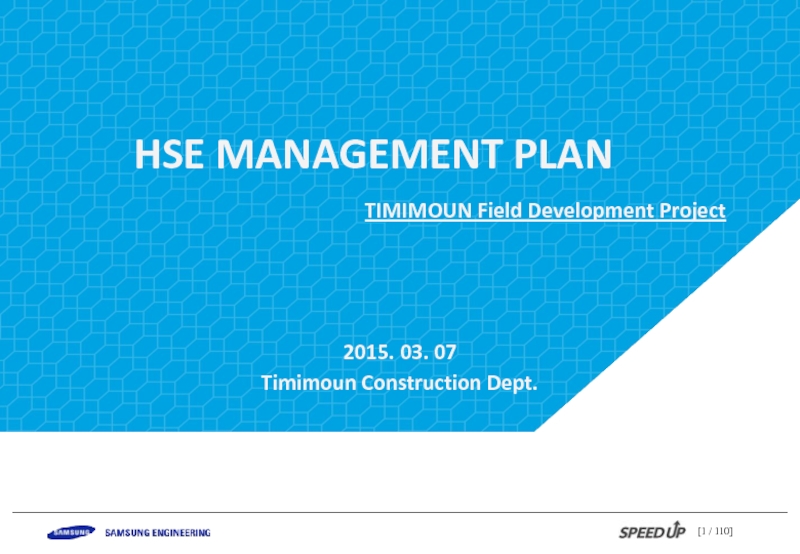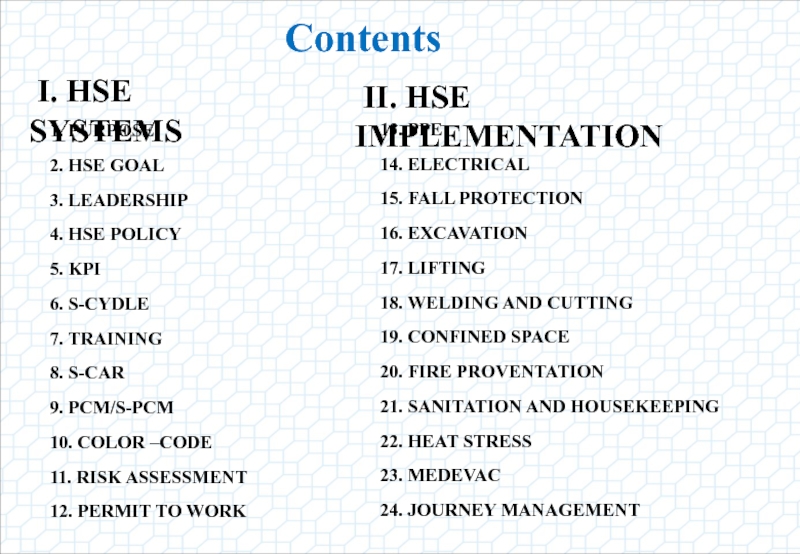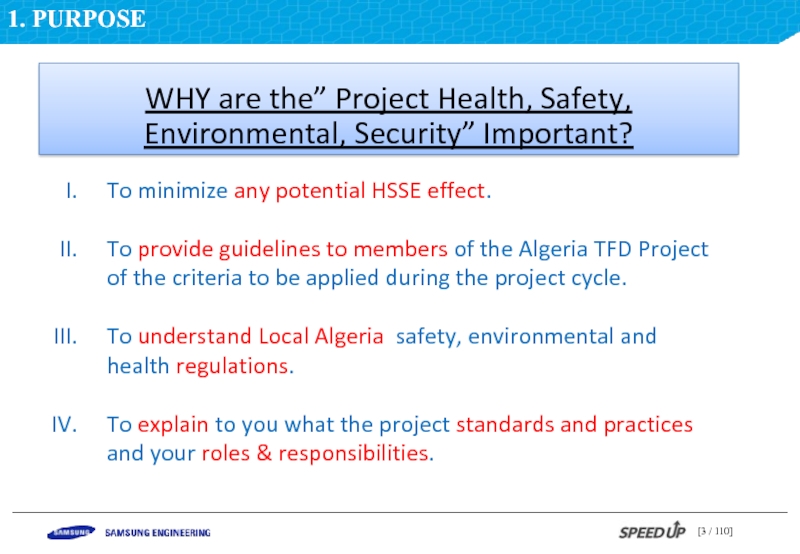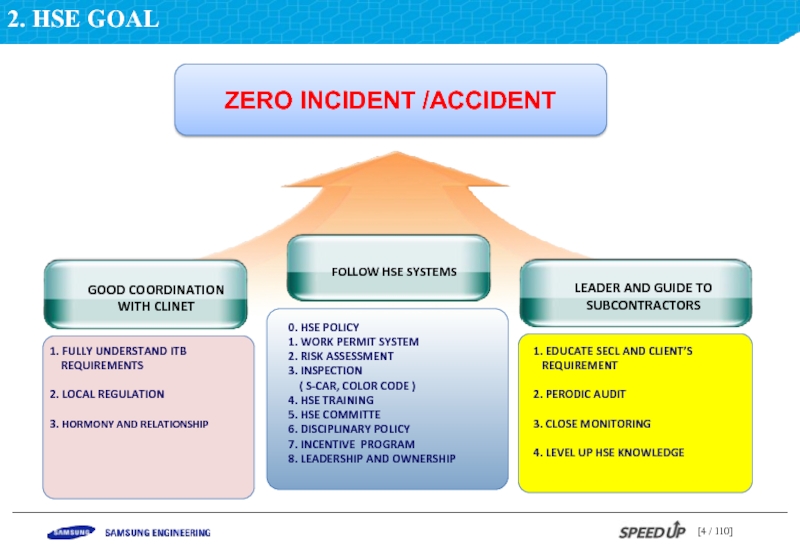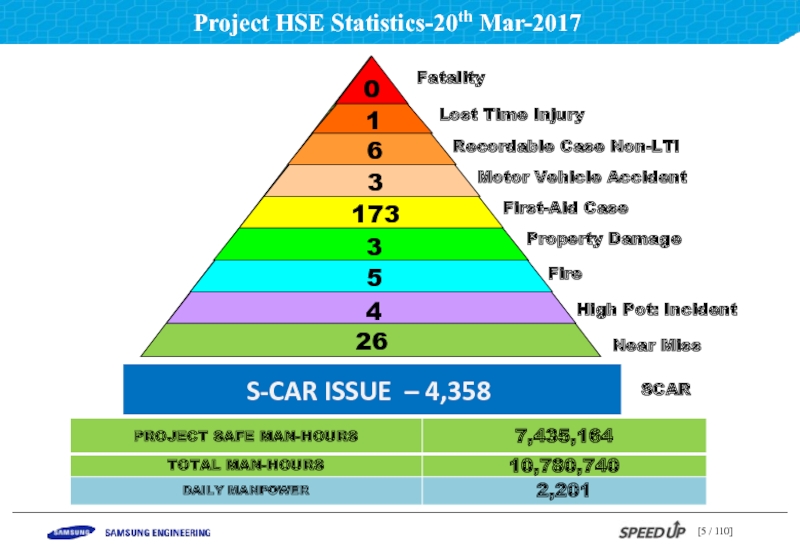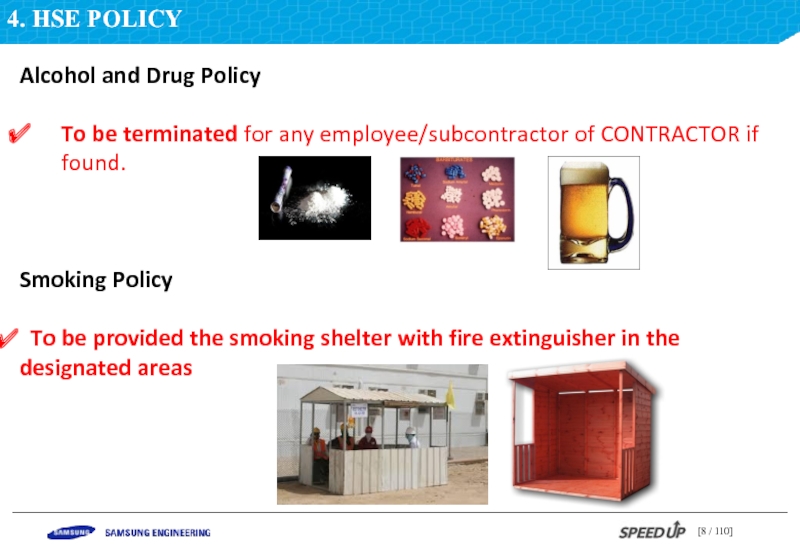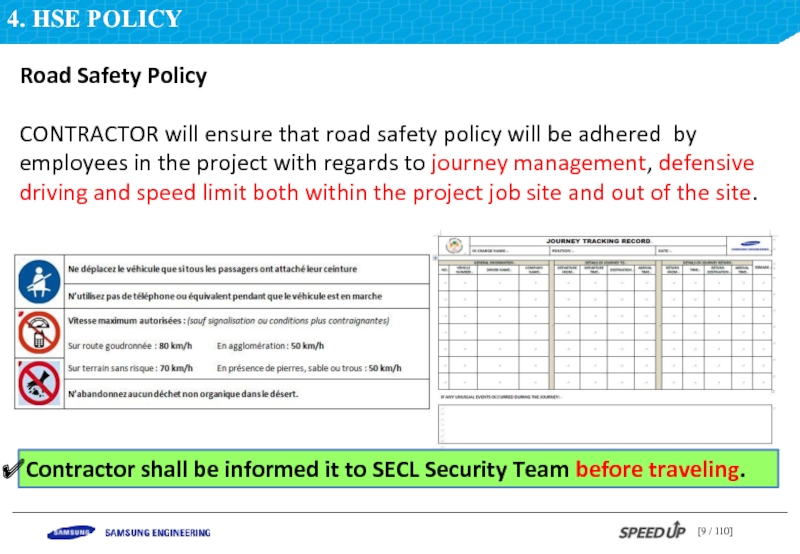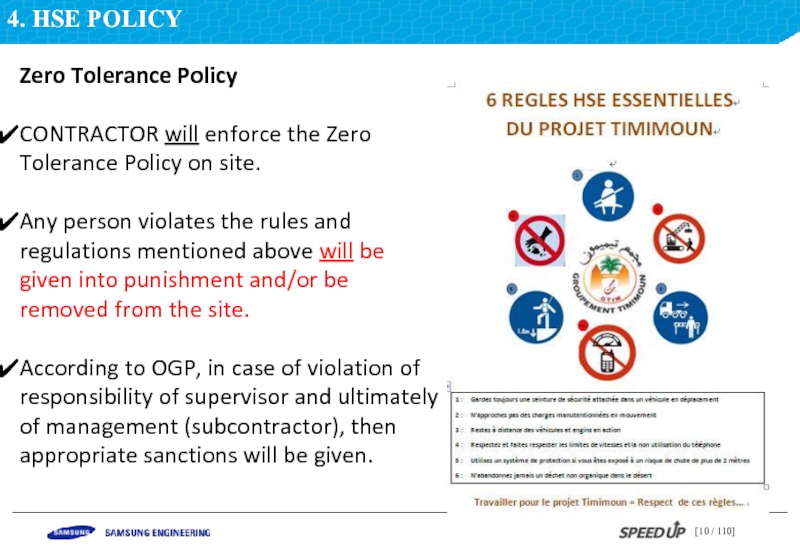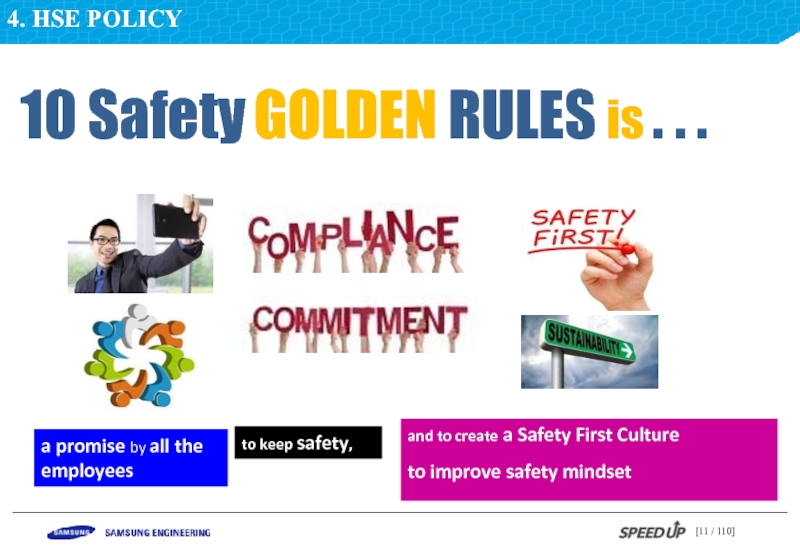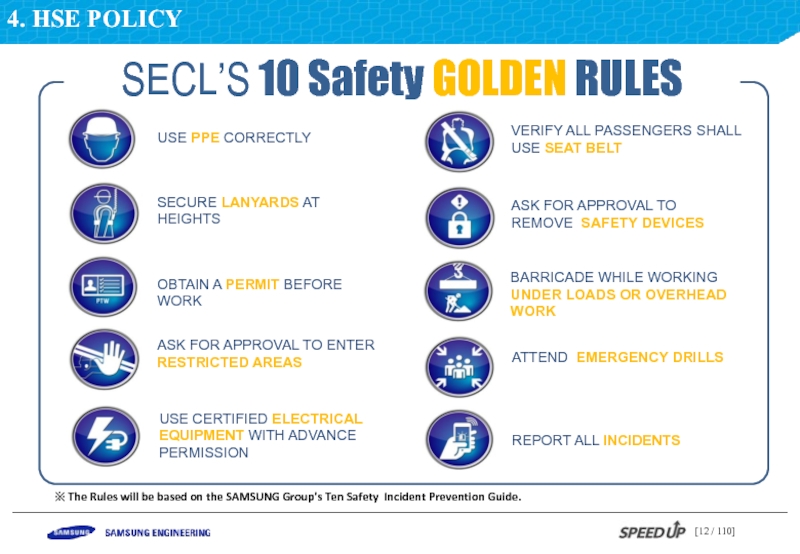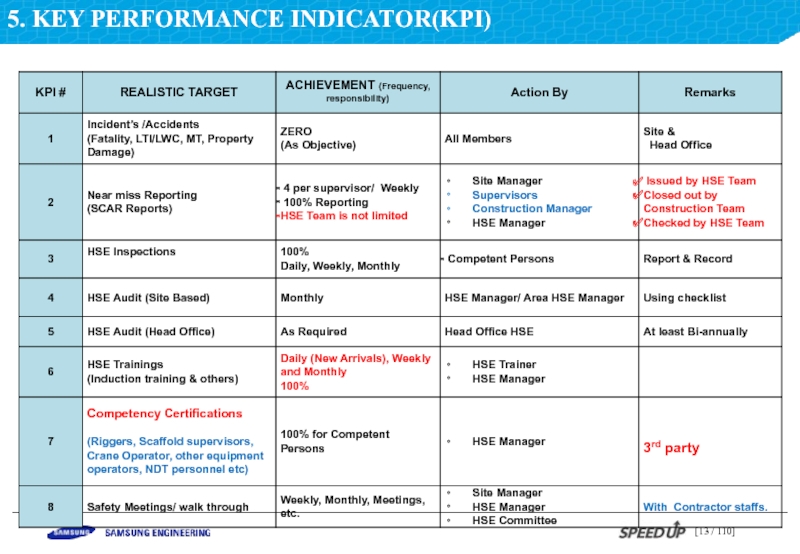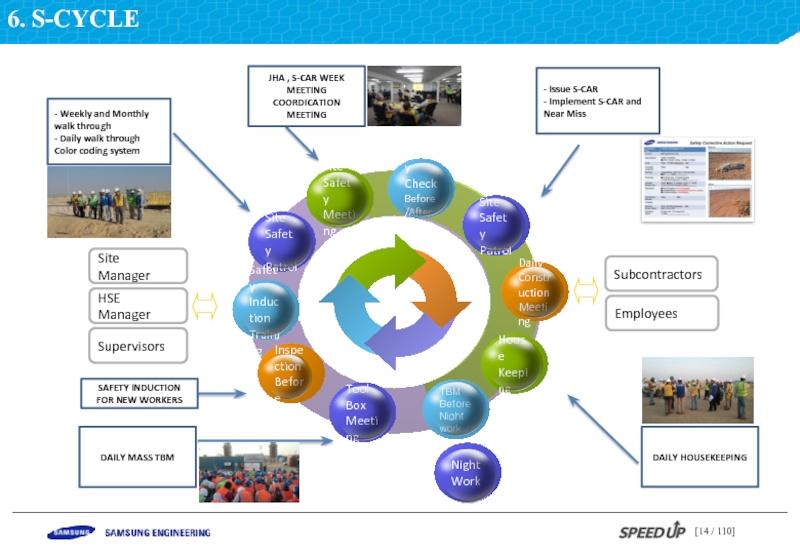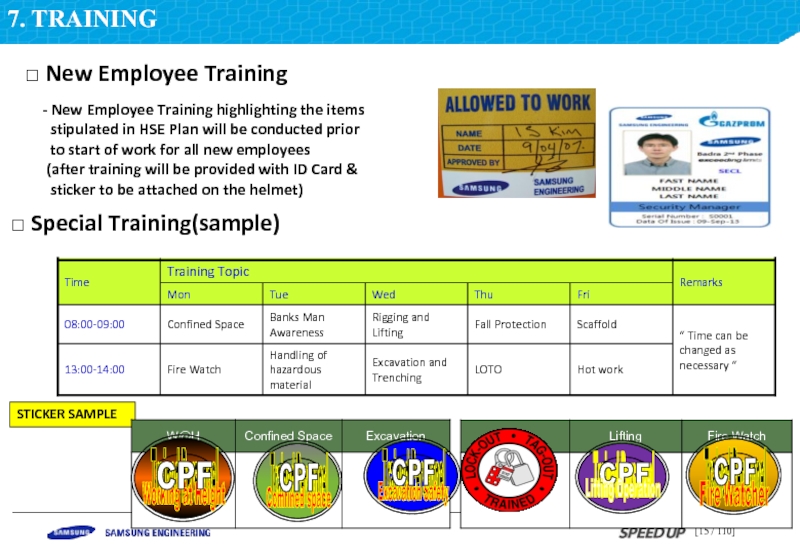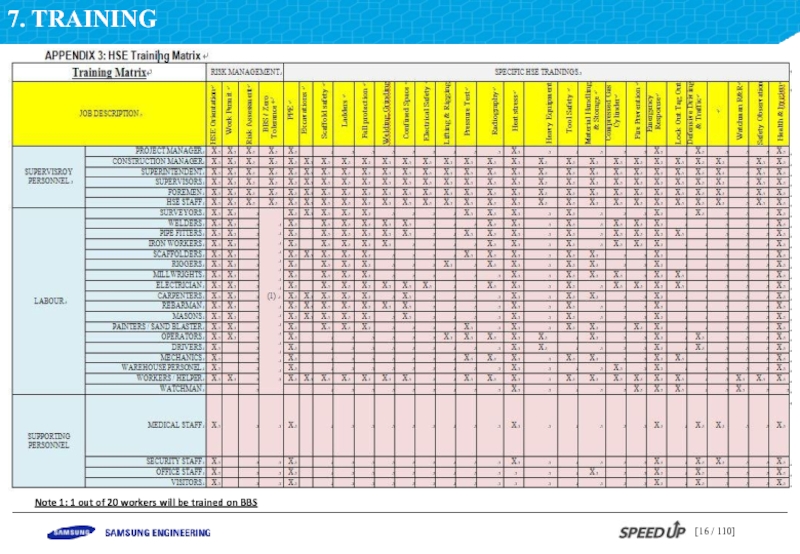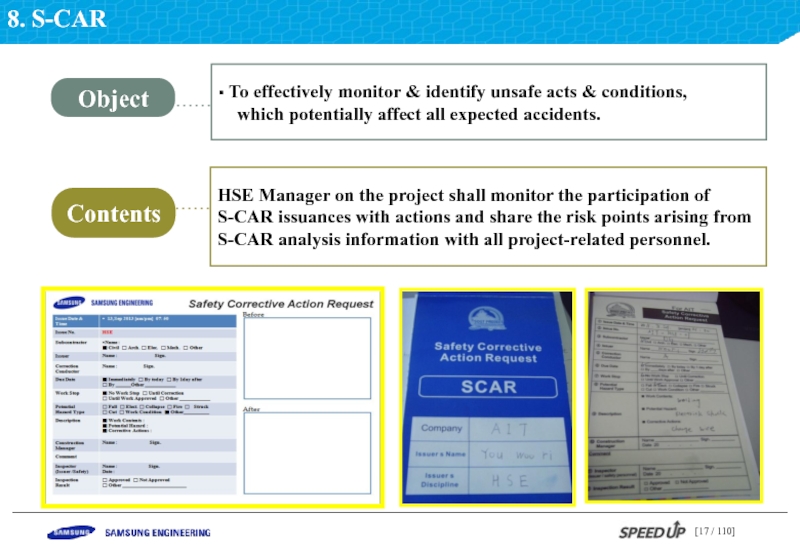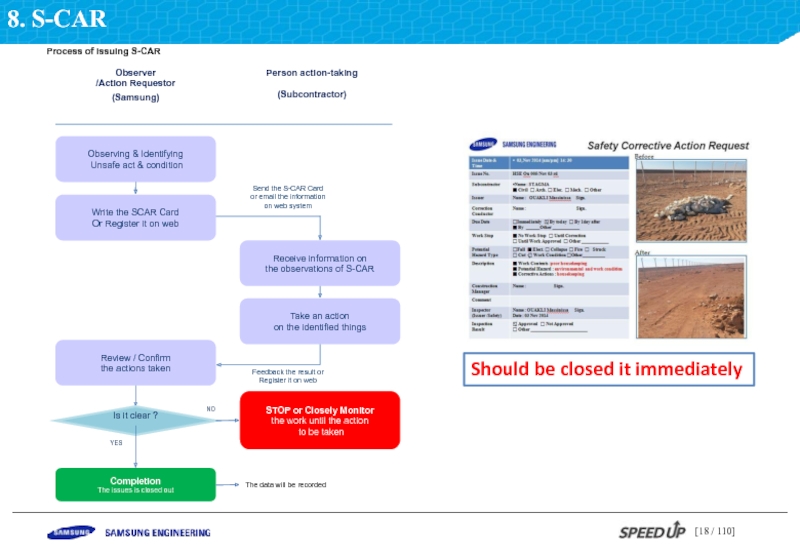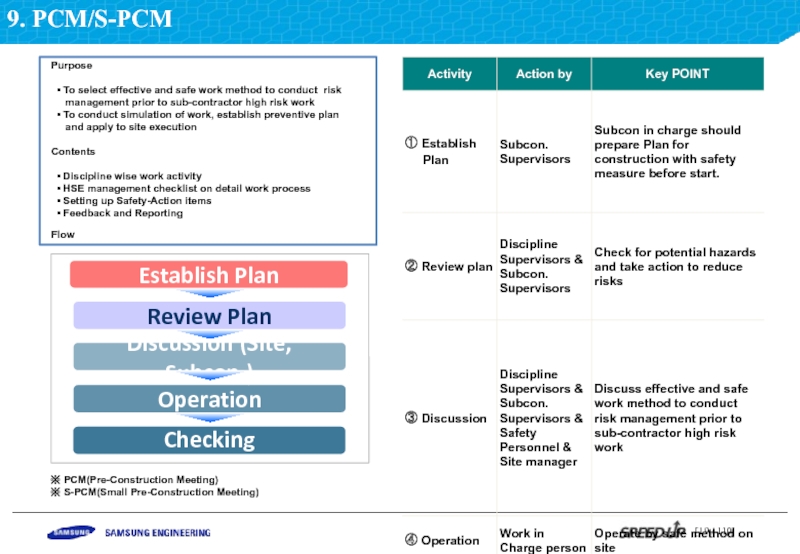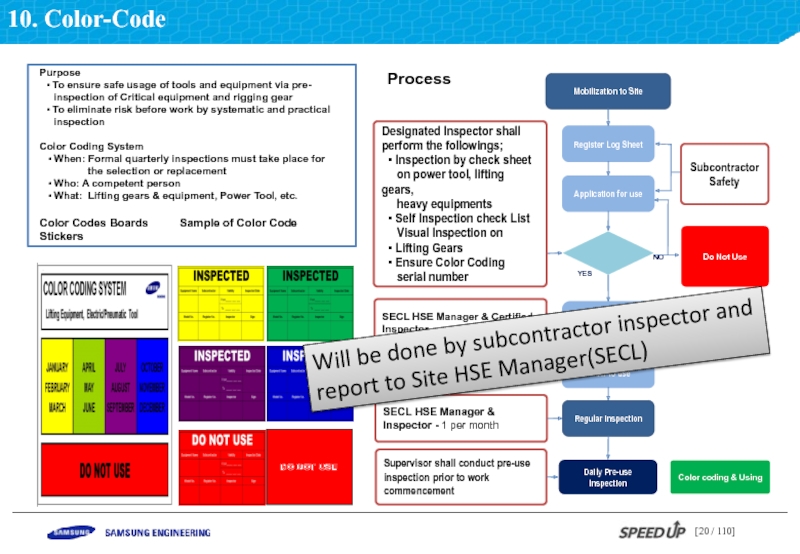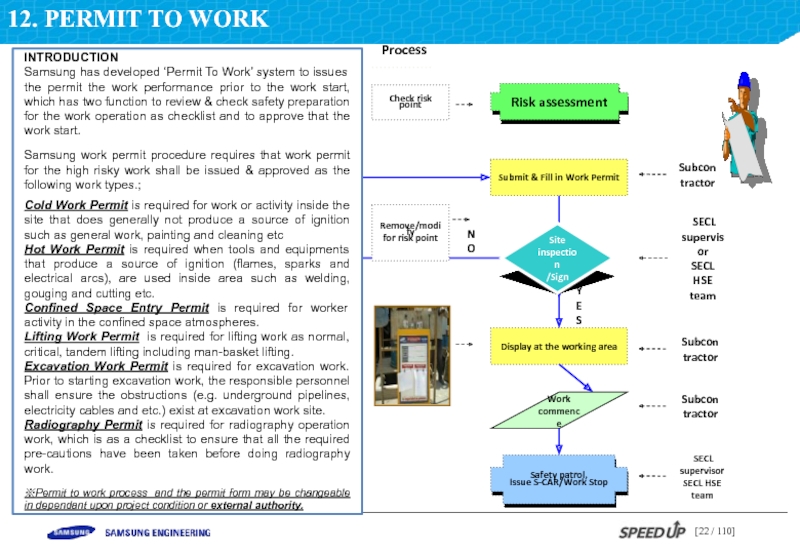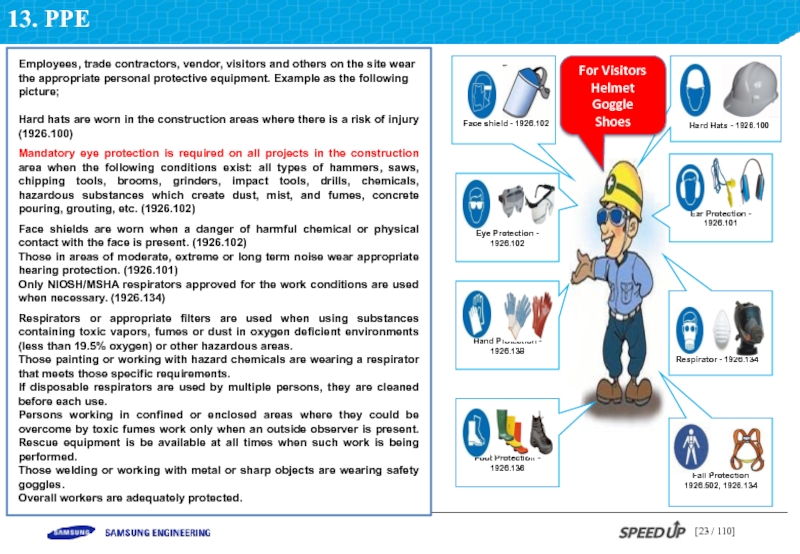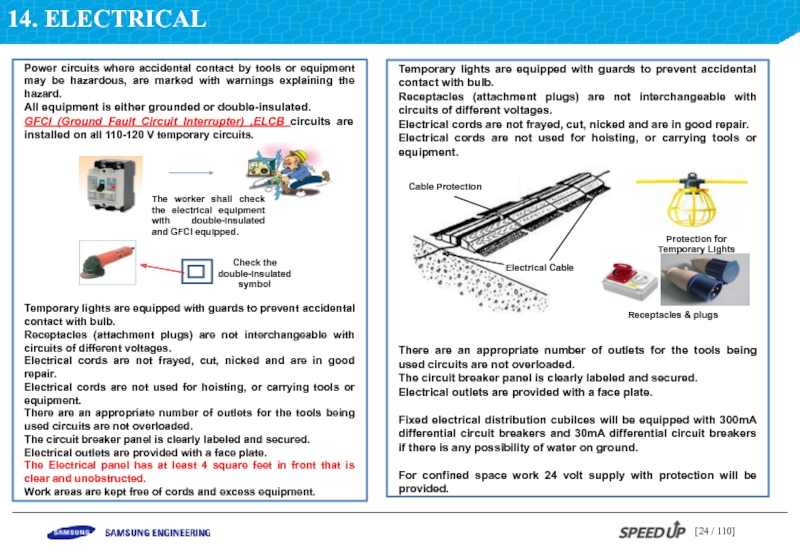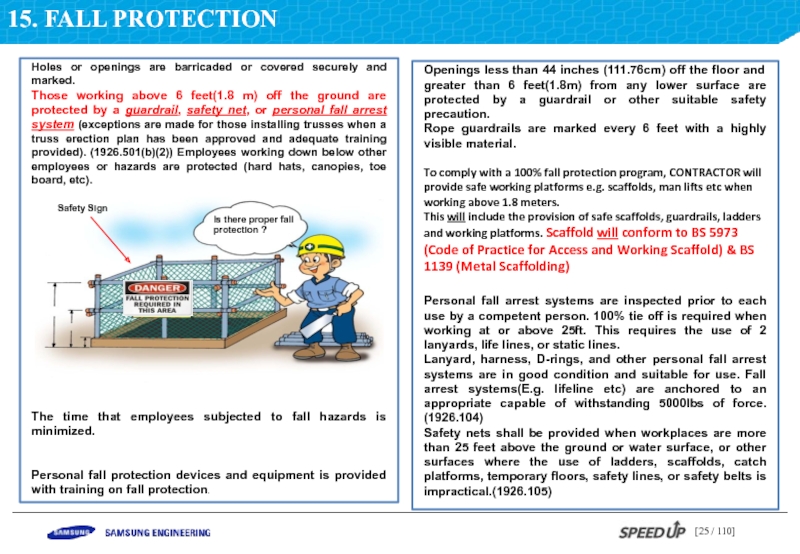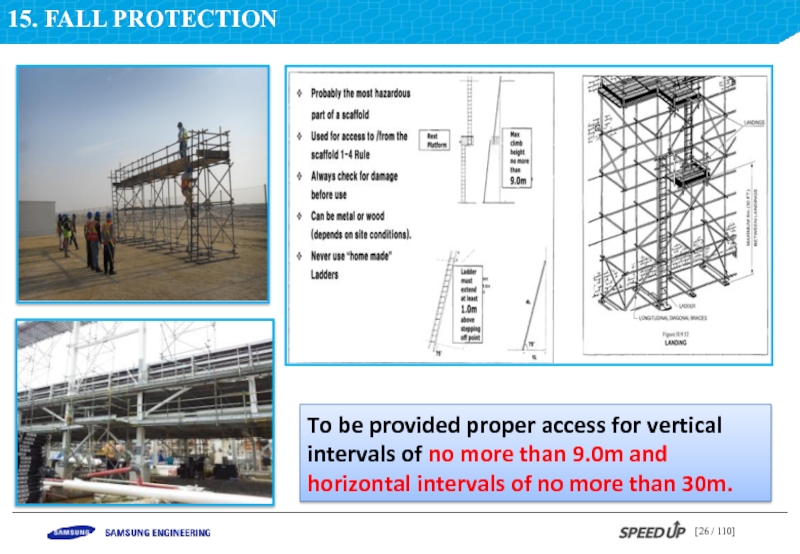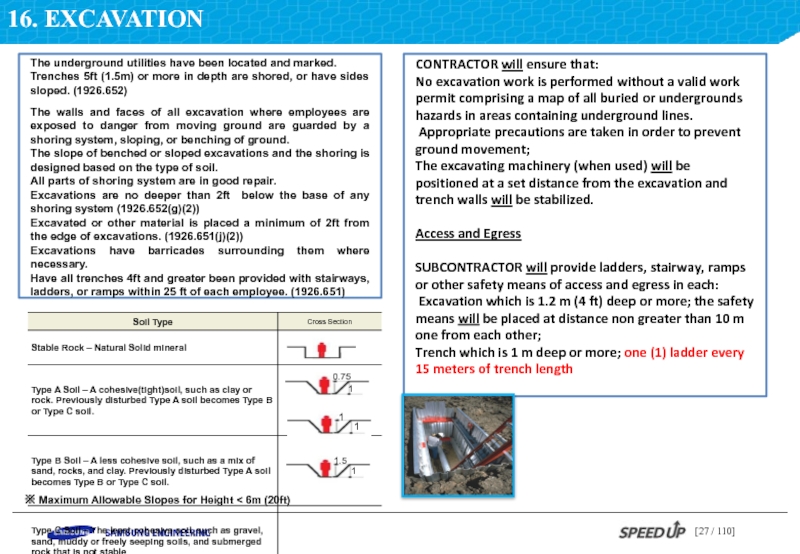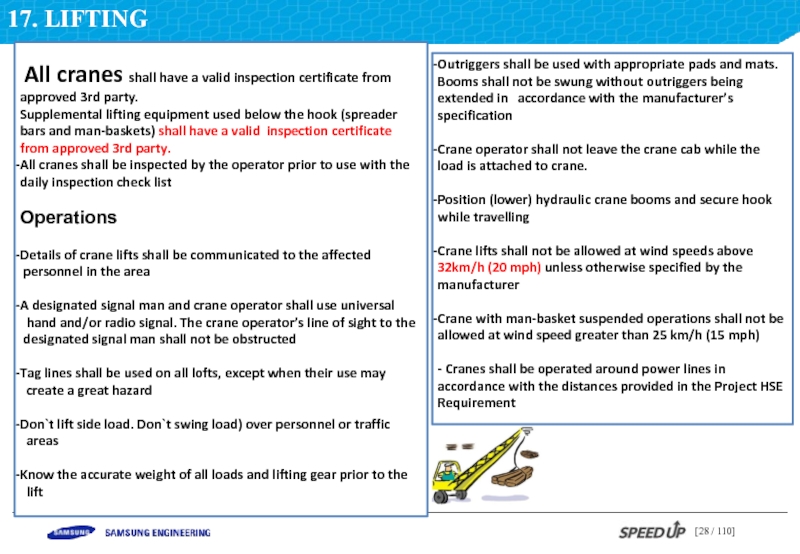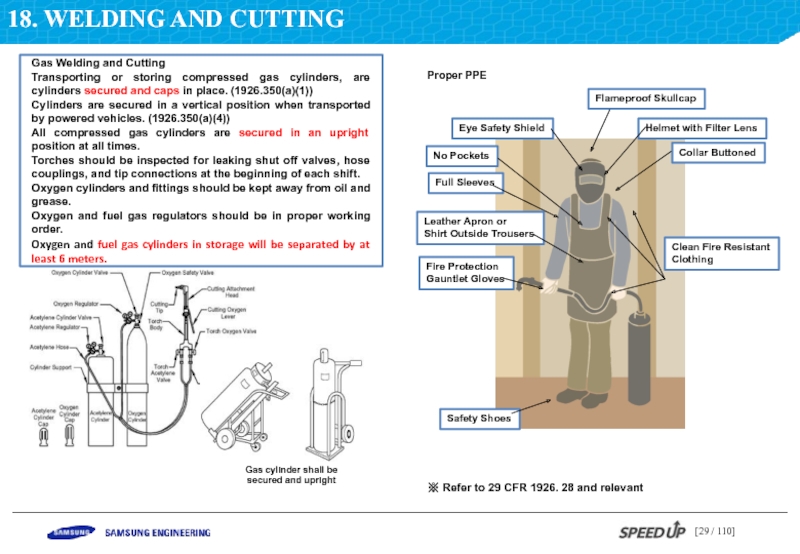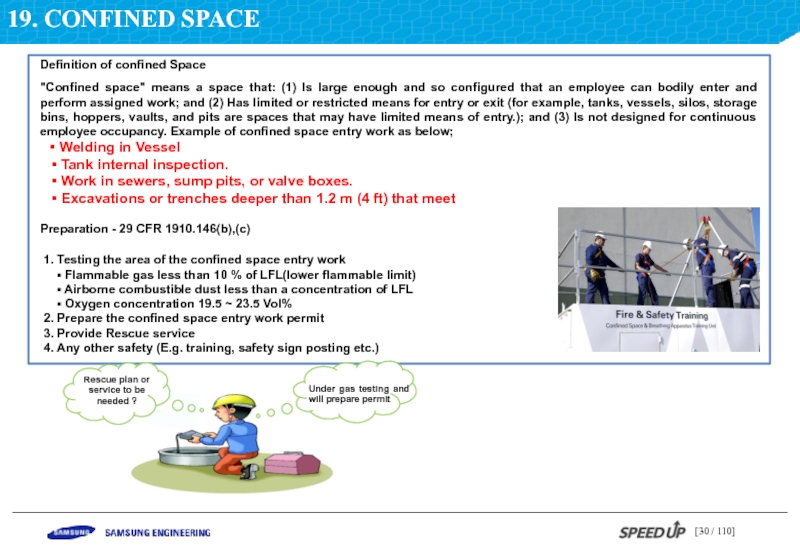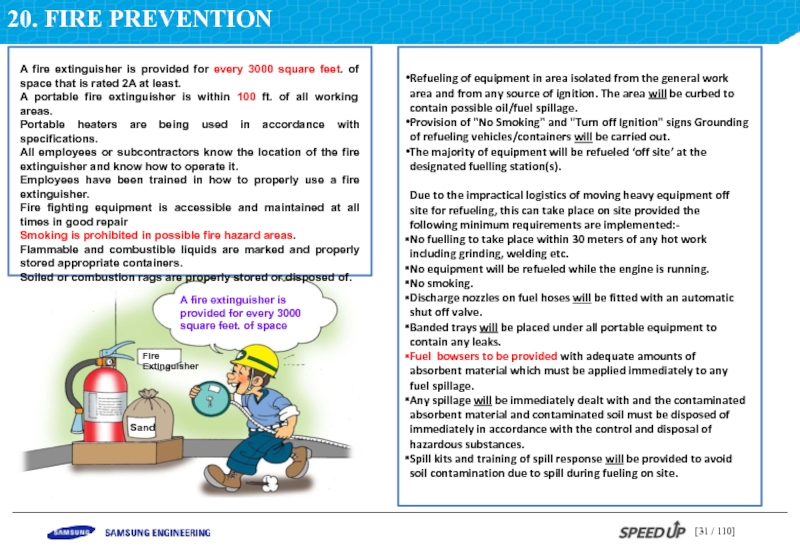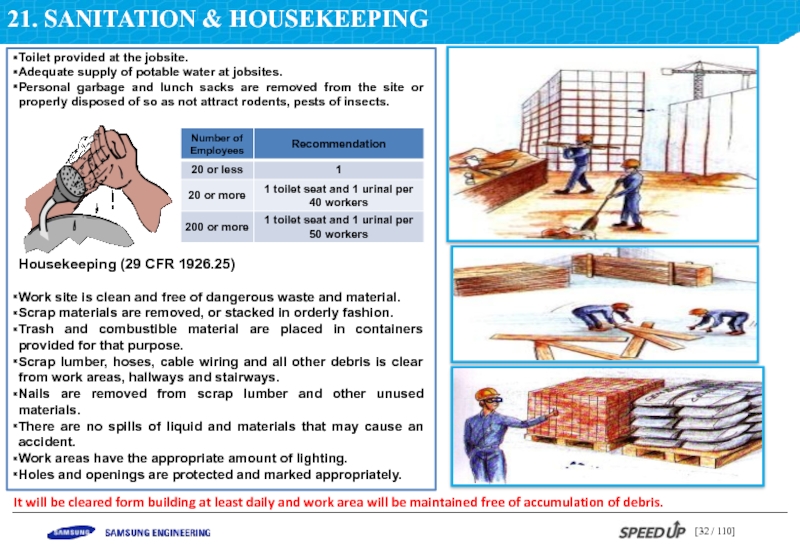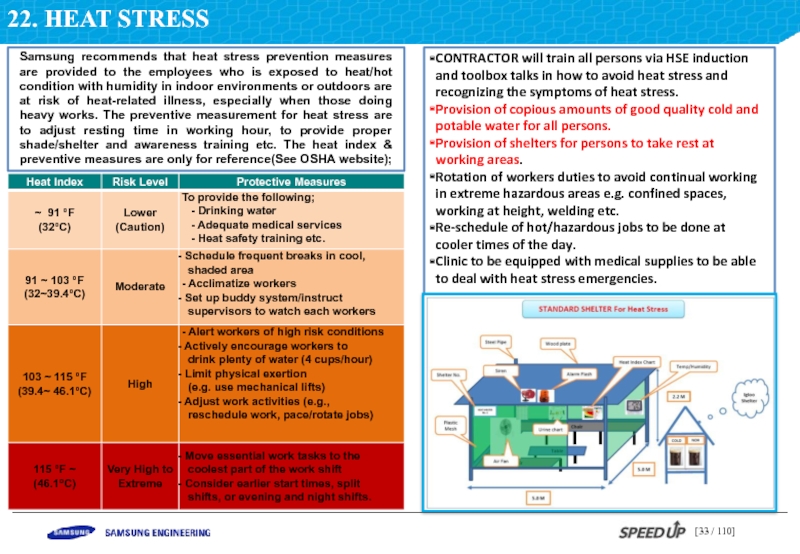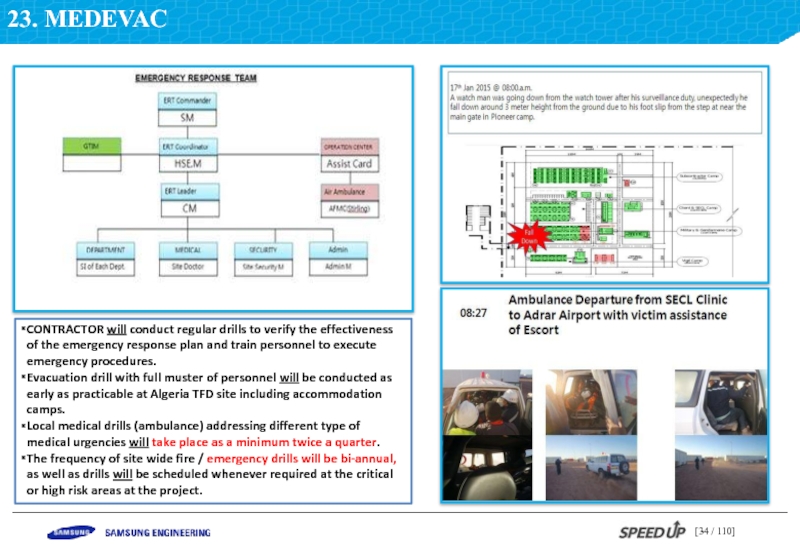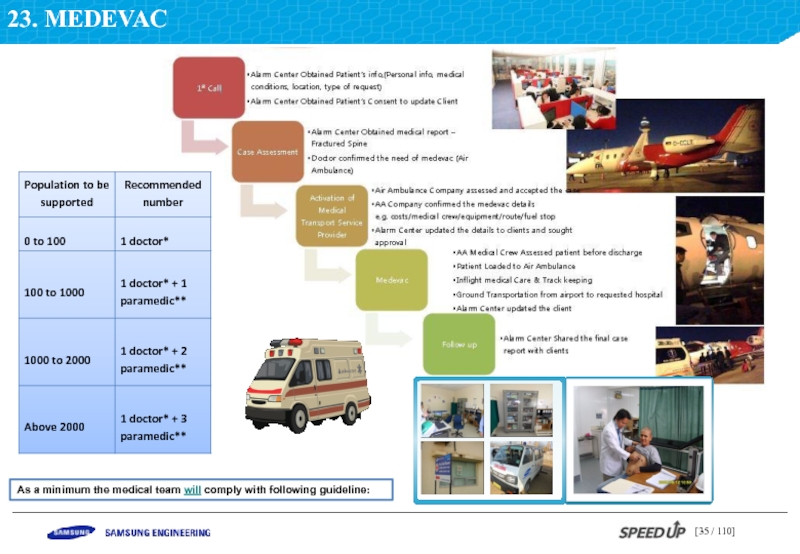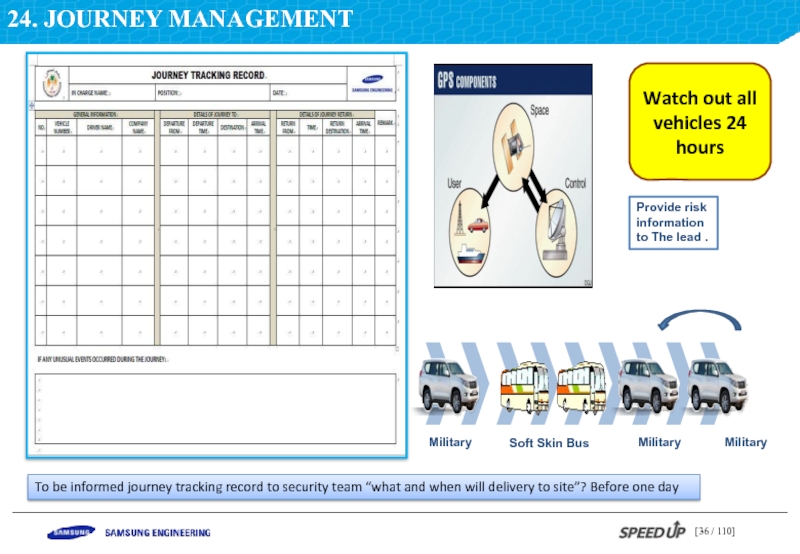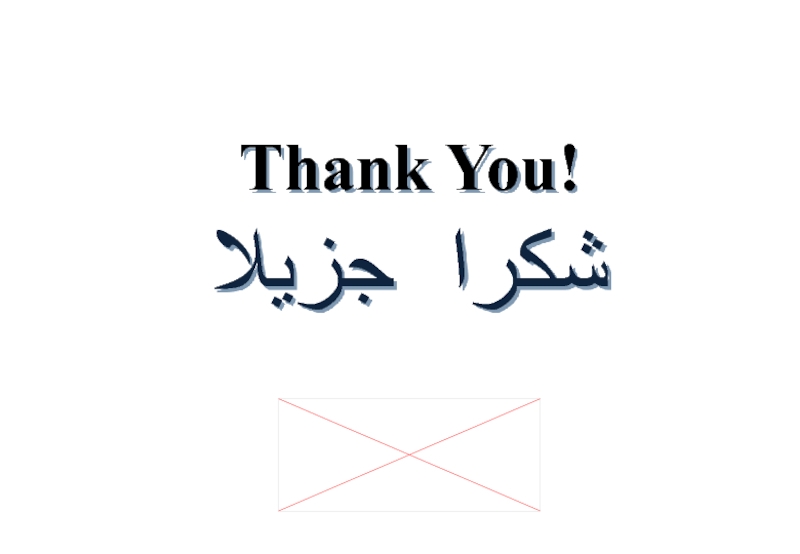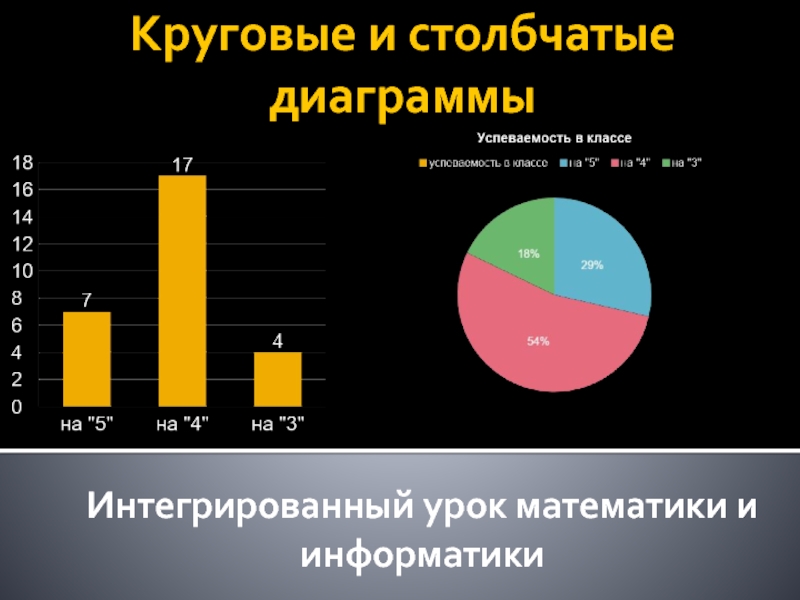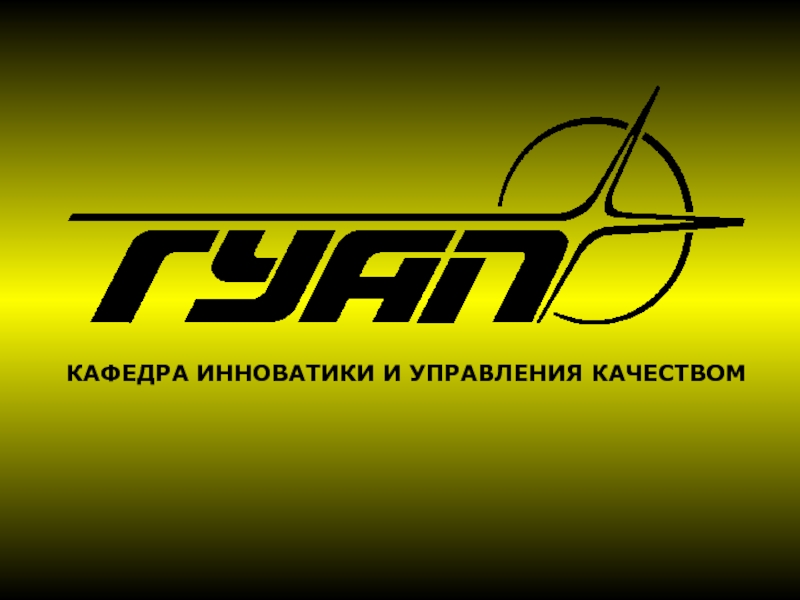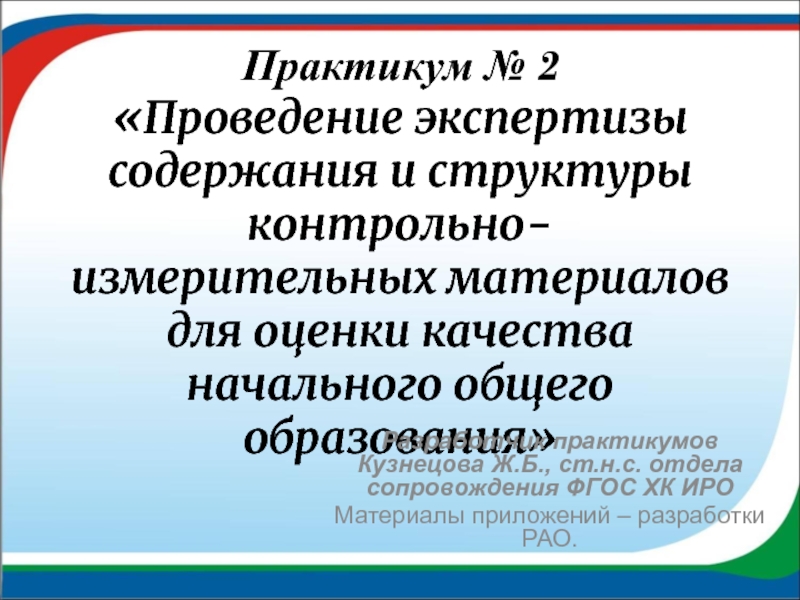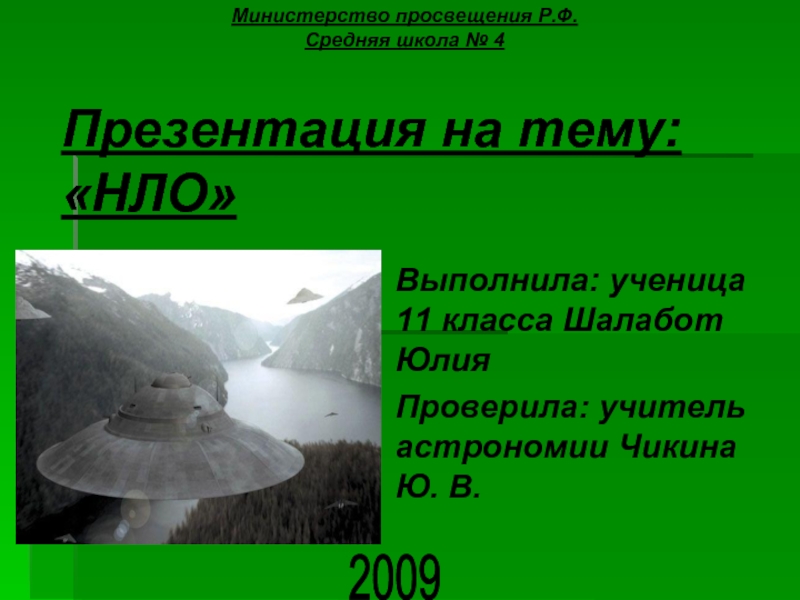- Главная
- Разное
- Дизайн
- Бизнес и предпринимательство
- Аналитика
- Образование
- Развлечения
- Красота и здоровье
- Финансы
- Государство
- Путешествия
- Спорт
- Недвижимость
- Армия
- Графика
- Культурология
- Еда и кулинария
- Лингвистика
- Английский язык
- Астрономия
- Алгебра
- Биология
- География
- Детские презентации
- Информатика
- История
- Литература
- Маркетинг
- Математика
- Медицина
- Менеджмент
- Музыка
- МХК
- Немецкий язык
- ОБЖ
- Обществознание
- Окружающий мир
- Педагогика
- Русский язык
- Технология
- Физика
- Философия
- Химия
- Шаблоны, картинки для презентаций
- Экология
- Экономика
- Юриспруденция
Hse management plan. Timimoun field development project презентация
Содержание
- 1. Hse management plan. Timimoun field development project
- 2. I. HSE SYSTEMS 1. PURPOSE 2.
- 3. 1. PURPOSE
- 4. 2. HSE GOAL ZERO INCIDENT /ACCIDENT
- 5. Project HSE Statistics-20th Mar-2017 High
- 6. 3. LEADERSHIP AND ACCOUNTABILITY CONTRACTOR shall ensure
- 7. 4. HSE POLICY
- 8. 4. HSE POLICY Alcohol and Drug Policy
- 9. 4. HSE POLICY Road Safety Policy
- 10. 4. HSE POLICY Zero Tolerance Policy
- 11. 4. HSE POLICY
- 12. 4. HSE POLICY
- 13. 5. KEY PERFORMANCE INDICATOR(KPI)
- 14. 6. S-CYCLE - Weekly and Monthly walk
- 15. 7. TRAINING
- 16. 7. TRAINING Note 1: 1 out of 20 workers will be trained on BBS
- 17. 8. S-CAR
- 18. 8. S-CAR Should be closed it immediately
- 19. 9. PCM/S-PCM
- 20. 10. Color-Code Process Will be done by subcontractor inspector and report to Site HSE Manager(SECL)
- 21. 11. RISK ASSESSMENT
- 22. 12. PERMIT TO WORK INTRODUCTION Samsung has
- 23. 13. PPE Employees, trade contractors, vendor,
- 24. 14. ELECTRICAL
- 25. 15. FALL PROTECTION Openings less than 44
- 26. 15. FALL PROTECTION To be provided proper
- 27. 16. EXCAVATION ※ Maximum Allowable Slopes for
- 28. 17. LIFTING All cranes shall have
- 29. 18. WELDING AND CUTTING
- 30. 19. CONFINED SPACE
- 31. 20. FIRE PREVENTION A fire extinguisher
- 32. 21. SANITATION & HOUSEKEEPING Toilet provided
- 33. 22. HEAT STRESS Samsung recommends that heat
- 34. 23. MEDEVAC CONTRACTOR will conduct regular drills
- 35. 23. MEDEVAC As a minimum the medical team will comply with following guideline:
- 36. 24. JOURNEY MANAGEMENT To be informed journey
- 37. Thank You! شكرا جزيلا
Слайд 2 I. HSE SYSTEMS
1. PURPOSE
2. HSE GOAL
3. LEADERSHIP
4. HSE POLICY
5. KPI
6.
7. TRAINING
8. S-CAR
9. PCM/S-PCM
10. COLOR –CODE
11. RISK ASSESSMENT
12. PERMIT TO WORK
Contents
II. HSE IMPLEMENTATION
13. PPE
14. ELECTRICAL
15. FALL PROTECTION
16. EXCAVATION
17. LIFTING
18. WELDING AND CUTTING
19. CONFINED SPACE
20. FIRE PROVENTATION
21. SANITATION AND HOUSEKEEPING
22. HEAT STRESS
23. MEDEVAC
24. JOURNEY MANAGEMENT
Слайд 63. LEADERSHIP AND ACCOUNTABILITY
CONTRACTOR shall ensure that adequate safety levels are
CONTRACTOR shall ensure that, during all the WORK execution, the social aspects are taken into account and well managed, ensuring good relationship with local communities and authorities, minimizing negative impacts and maximizing positive impacts on them.
CONTRACTOR shall bear the cost and any and all impact on the WORK TIME SCHEDULE resulting from, or otherwise connected with any of the following actions:
Meet the specified HSE regulations and other safety related requirements;
Perform the WORK in accordance with well-accepted safe working practice in the oil and gas industry and
established available industry practices for environmental performance;
Meet all HSE requirements defined in the CONTRACT;
Measures and actions taken by GTIM in lieu of CONTRACTOR on the grounds of CONTRACTOR failing to take
the necessary HSE measures and actions;
Assessment, control and mitigation of Security and societal risks.
Слайд 84. HSE POLICY
Alcohol and Drug Policy
To be terminated for any employee/subcontractor
Smoking Policy
To be provided the smoking shelter with fire extinguisher in the designated areas
Слайд 94. HSE POLICY
Road Safety Policy
CONTRACTOR will ensure that road safety policy
Contractor shall be informed it to SECL Security Team before traveling.
Слайд 104. HSE POLICY
Zero Tolerance Policy
CONTRACTOR will enforce the Zero Tolerance Policy
Any person violates the rules and regulations mentioned above will be given into punishment and/or be removed from the site.
According to OGP, in case of violation of responsibility of supervisor and ultimately of management (subcontractor), then appropriate sanctions will be given.
Слайд 146. S-CYCLE
- Weekly and Monthly walk through
- Daily walk through
Color coding
JHA , S-CAR WEEK MEETING
COORDICATION MEETING
DAILY MASS TBM
DAILY HOUSEKEEPING
- Issue S-CAR
- Implement S-CAR and Near Miss
SAFETY INDUCTION FOR NEW WORKERS
Слайд 2010. Color-Code
Process
Will be done by subcontractor inspector and report to Site
Слайд 2212. PERMIT TO WORK
INTRODUCTION
Samsung has developed ‘Permit To Work’ system to
Samsung work permit procedure requires that work permit for the high risky work shall be issued & approved as the following work types.;
Cold Work Permit is required for work or activity inside the site that does generally not produce a source of ignition such as general work, painting and cleaning etc
Hot Work Permit is required when tools and equipments that produce a source of ignition (flames, sparks and electrical arcs), are used inside area such as welding, gouging and cutting etc.
Confined Space Entry Permit is required for worker activity in the confined space atmospheres.
Lifting Work Permit is required for lifting work as normal, critical, tandem lifting including man-basket lifting.
Excavation Work Permit is required for excavation work. Prior to starting excavation work, the responsible personnel shall ensure the obstructions (e.g. underground pipelines, electricity cables and etc.) exist at excavation work site.
Radiography Permit is required for radiography operation work, which is as a checklist to ensure that all the required pre-cautions have been taken before doing radiography work.
※Permit to work process and the permit form may be changeable in dependant upon project condition or external authority.
Слайд 2313. PPE
Employees, trade contractors, vendor, visitors and others on the site
Hard hats are worn in the construction areas where there is a risk of injury (1926.100)
Mandatory eye protection is required on all projects in the construction area when the following conditions exist: all types of hammers, saws, chipping tools, brooms, grinders, impact tools, drills, chemicals, hazardous substances which create dust, mist, and fumes, concrete pouring, grouting, etc. (1926.102)
Face shields are worn when a danger of harmful chemical or physical contact with the face is present. (1926.102)
Those in areas of moderate, extreme or long term noise wear appropriate hearing protection. (1926.101)
Only NIOSH/MSHA respirators approved for the work conditions are used when necessary. (1926.134)
Respirators or appropriate filters are used when using substances containing toxic vapors, fumes or dust in oxygen deficient environments (less than 19.5% oxygen) or other hazardous areas.
Those painting or working with hazard chemicals are wearing a respirator that meets those specific requirements.
If disposable respirators are used by multiple persons, they are cleaned before each use.
Persons working in confined or enclosed areas where they could be overcome by toxic fumes work only when an outside observer is present. Rescue equipment is be available at all times when such work is being performed.
Those welding or working with metal or sharp objects are wearing safety goggles.
Overall workers are adequately protected.
For Visitors
Helmet
Goggle
Shoes
Слайд 2515. FALL PROTECTION
Openings less than 44 inches (111.76cm) off the floor
Rope guardrails are marked every 6 feet with a highly visible material.
To comply with a 100% fall protection program, CONTRACTOR will provide safe working platforms e.g. scaffolds, man lifts etc when working above 1.8 meters.
This will include the provision of safe scaffolds, guardrails, ladders and working platforms. Scaffold will conform to BS 5973 (Code of Practice for Access and Working Scaffold) & BS 1139 (Metal Scaffolding)
Personal fall arrest systems are inspected prior to each use by a competent person. 100% tie off is required when working at or above 25ft. This requires the use of 2 lanyards, life lines, or static lines.
Lanyard, harness, D-rings, and other personal fall arrest systems are in good condition and suitable for use. Fall arrest systems(E.g. lifeline etc) are anchored to an appropriate capable of withstanding 5000lbs of force. (1926.104)
Safety nets shall be provided when workplaces are more than 25 feet above the ground or water surface, or other surfaces where the use of ladders, scaffolds, catch platforms, temporary floors, safety lines, or safety belts is impractical.(1926.105)
Слайд 2615. FALL PROTECTION
To be provided proper access for vertical intervals of
Слайд 2716. EXCAVATION
※ Maximum Allowable Slopes for Height < 6m (20ft)
The underground
Trenches 5ft (1.5m) or more in depth are shored, or have sides sloped. (1926.652)
The walls and faces of all excavation where employees are exposed to danger from moving ground are guarded by a shoring system, sloping, or benching of ground.
The slope of benched or sloped excavations and the shoring is designed based on the type of soil.
All parts of shoring system are in good repair.
Excavations are no deeper than 2ft below the base of any shoring system (1926.652(g)(2))
Excavated or other material is placed a minimum of 2ft from the edge of excavations. (1926.651(j)(2))
Excavations have barricades surrounding them where necessary.
Have all trenches 4ft and greater been provided with stairways, ladders, or ramps within 25 ft of each employee. (1926.651)
CONTRACTOR will ensure that:
No excavation work is performed without a valid work permit comprising a map of all buried or undergrounds hazards in areas containing underground lines.
Appropriate precautions are taken in order to prevent ground movement;
The excavating machinery (when used) will be positioned at a set distance from the excavation and trench walls will be stabilized.
Access and Egress
SUBCONTRACTOR will provide ladders, stairway, ramps or other safety means of access and egress in each:
Excavation which is 1.2 m (4 ft) deep or more; the safety means will be placed at distance non greater than 10 m one from each other;
Trench which is 1 m deep or more; one (1) ladder every 15 meters of trench length
Слайд 2817. LIFTING
All cranes shall have a valid inspection certificate from
Supplemental lifting equipment used below the hook (spreader bars and man-baskets) shall have a valid inspection certificate from approved 3rd party.
All cranes shall be inspected by the operator prior to use with the daily inspection check list
Operations
Details of crane lifts shall be communicated to the affected
personnel in the area
A designated signal man and crane operator shall use universal
hand and/or radio signal. The crane operator’s line of sight to the
designated signal man shall not be obstructed
Tag lines shall be used on all lofts, except when their use may
create a great hazard
Don`t lift side load. Don`t swing load) over personnel or traffic
areas
Know the accurate weight of all loads and lifting gear prior to the
lift
Outriggers shall be used with appropriate pads and mats. Booms shall not be swung without outriggers being extended in accordance with the manufacturer’s specification
Crane operator shall not leave the crane cab while the load is attached to crane.
Position (lower) hydraulic crane booms and secure hook while travelling
Crane lifts shall not be allowed at wind speeds above 32km/h (20 mph) unless otherwise specified by the manufacturer
Crane with man-basket suspended operations shall not be allowed at wind speed greater than 25 km/h (15 mph)
- Cranes shall be operated around power lines in accordance with the distances provided in the Project HSE Requirement
Слайд 3120. FIRE PREVENTION
A fire extinguisher is provided for every 3000 square
A portable fire extinguisher is within 100 ft. of all working areas.
Portable heaters are being used in accordance with specifications.
All employees or subcontractors know the location of the fire extinguisher and know how to operate it.
Employees have been trained in how to properly use a fire extinguisher.
Fire fighting equipment is accessible and maintained at all times in good repair
Smoking is prohibited in possible fire hazard areas.
Flammable and combustible liquids are marked and properly stored appropriate containers.
Soiled or combustion rags are properly stored or disposed of.
Refueling of equipment in area isolated from the general work area and from any source of ignition. The area will be curbed to contain possible oil/fuel spillage.
Provision of "No Smoking" and "Turn off Ignition" signs Grounding of refueling vehicles/containers will be carried out.
The majority of equipment will be refueled ‘off site’ at the designated fuelling station(s).
Due to the impractical logistics of moving heavy equipment off site for refueling, this can take place on site provided the following minimum requirements are implemented:-
No fuelling to take place within 30 meters of any hot work including grinding, welding etc.
No equipment will be refueled while the engine is running.
No smoking.
Discharge nozzles on fuel hoses will be fitted with an automatic shut off valve.
Banded trays will be placed under all portable equipment to contain any leaks.
Fuel bowsers to be provided with adequate amounts of absorbent material which must be applied immediately to any fuel spillage.
Any spillage will be immediately dealt with and the contaminated absorbent material and contaminated soil must be disposed of immediately in accordance with the control and disposal of hazardous substances.
Spill kits and training of spill response will be provided to avoid soil contamination due to spill during fueling on site.
Слайд 3221. SANITATION & HOUSEKEEPING
Toilet provided at the jobsite.
Adequate supply of potable
Personal garbage and lunch sacks are removed from the site or properly disposed of so as not attract rodents, pests of insects.
Housekeeping (29 CFR 1926.25)
Work site is clean and free of dangerous waste and material.
Scrap materials are removed, or stacked in orderly fashion.
Trash and combustible material are placed in containers provided for that purpose.
Scrap lumber, hoses, cable wiring and all other debris is clear from work areas, hallways and stairways.
Nails are removed from scrap lumber and other unused materials.
There are no spills of liquid and materials that may cause an accident.
Work areas have the appropriate amount of lighting.
Holes and openings are protected and marked appropriately.
It will be cleared form building at least daily and work area will be maintained free of accumulation of debris.
Слайд 3322. HEAT STRESS
Samsung recommends that heat stress prevention measures are provided
CONTRACTOR will train all persons via HSE induction and toolbox talks in how to avoid heat stress and recognizing the symptoms of heat stress.
Provision of copious amounts of good quality cold and potable water for all persons.
Provision of shelters for persons to take rest at working areas.
Rotation of workers duties to avoid continual working in extreme hazardous areas e.g. confined spaces, working at height, welding etc.
Re-schedule of hot/hazardous jobs to be done at cooler times of the day.
Clinic to be equipped with medical supplies to be able to deal with heat stress emergencies.
Слайд 3423. MEDEVAC
CONTRACTOR will conduct regular drills to verify the effectiveness of
Evacuation drill with full muster of personnel will be conducted as early as practicable at Algeria TFD site including accommodation camps.
Local medical drills (ambulance) addressing different type of medical urgencies will take place as a minimum twice a quarter.
The frequency of site wide fire / emergency drills will be bi-annual, as well as drills will be scheduled whenever required at the critical or high risk areas at the project.
